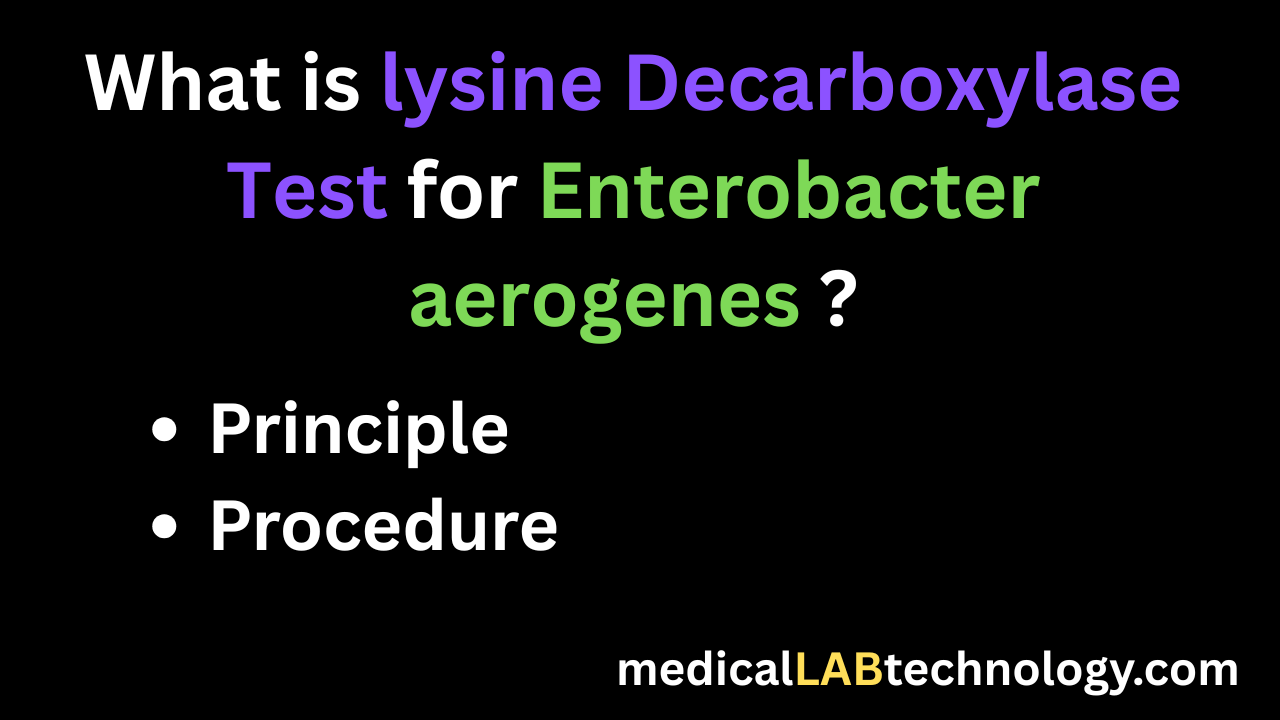The Lysine Decarboxylase Test is a vital biochemical assay in microbiology. It identifies bacterial species based on their ability to decarboxylate the amino acid lysine.
One common organism tested using this method is Enterobacter aerogenes (now reclassified as Klebsiella aerogenes). It is a gram-negative, facultatively anaerobic bacillus found in soil, water, and the human gastrointestinal tract.
What is the Lysine Decarboxylase Test?
The lysine decarboxylase test checks if a bacterium can produce the enzyme lysine decarboxylase. This enzyme breaks down lysine into cadaverine, an alkaline amine.
This biochemical reaction is an essential tool in identifying and differentiating members of the Enterobacteriaceae family, like Enterobacter aerogenes.
Principle of Lysine Decarboxylase Test for Enterobacter aerogenes
The principle of the test revolves around the fermentation of glucose and the decarboxylation of lysine under anaerobic conditions. Here’s how it works:
- Enterobacter aerogenes first ferments glucose in the test medium, producing acidic byproducts that lower the pH.
- The acidic environment activates the lysine decarboxylase enzyme, which decarboxylates lysine to produce cadaverine and carbon dioxide.
- The production of cadaverine increases the pH, causing the medium to turn purple, indicating a positive result.
- A pH indicator (usually bromocresol purple) helps visualize the color change.
Materials Required for Lysine Decarboxylase Test for Enterobacter aerogenes
Media
- Moeller’s Decarboxylase Base Medium (without amino acids)
- Supplemented with 1% L-lysine
Reagents
- Bromocresol purple (pH indicator)
- Sterile mineral oil (to create anaerobic conditions)
Equipment
- Test tubes
- Inoculating loop
- Incubator (35–37°C)
- Sterile pipette
Procedure for Lysine Decarboxylase Test (Enterobacter aerogenes)
Follow these steps to perform the lysine decarboxylase test on Enterobacter aerogenes:
1. Media Preparation
- Prepare Moeller’s base medium according to instructions.
- Add 1% L-lysine to the test tube.
- Dispense into test tubes and sterilize via autoclaving.
2. Inoculation
- Inoculate E. aerogenes into two tubes:
- One tube with lysine-supplemented medium (test)
- One tube with base medium only (control)
3. Anaerobic Setup
- Overlay both tubes with 1 cm of sterile mineral oil to create anaerobic conditions.
4. Incubation
- Incubate at 35–37°C for 18–48 hours.
5. Result Observation
- Positive Result: The medium turns purple, indicating lysine decarboxylation.
- Negative Result: The medium remains yellow, showing no enzyme activity.
Expected Result for Enterobacter aerogenes

Enterobacter aerogenes typically gives a positive lysine decarboxylase result, confirming its ability to produce the lysine decarboxylase enzyme.
Significance of the Test
- Helps differentiate Enterobacter aerogenes from other gram-negative bacilli like Citrobacter, Shigella, or Salmonella.
- Used in clinical diagnostics to confirm the identity of Enterobacter species.
- Plays a role in quality control in pharmaceutical and food microbiology labs.
Conclusion
The lysine decarboxylase test is a powerful diagnostic tool that confirms the metabolic capabilities of Enterobacter aerogenes.

NICE SIR
THAKYOU
nice information sir